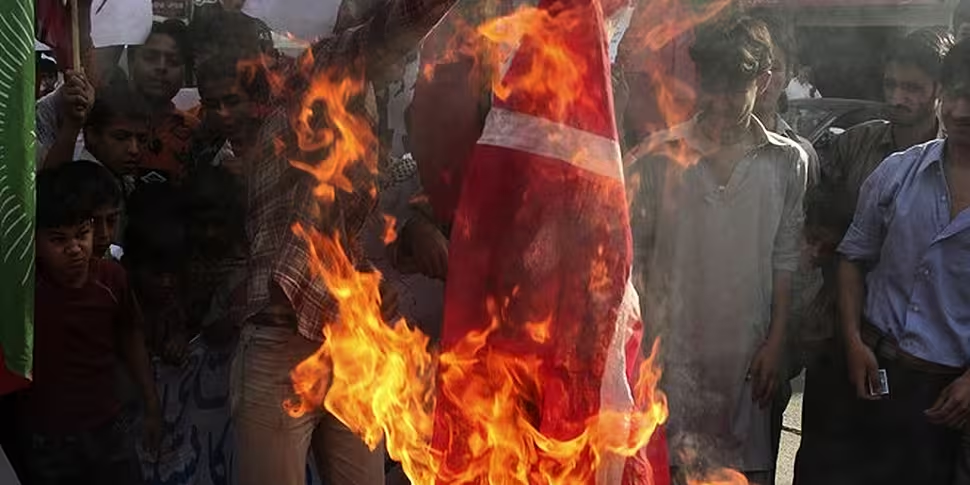Today, September 30th, marks a decade since Danish newspapers published a number of satirical cartoons of the Prophet Muhammad. The images, twelve in total depicting the founder of the Islamic church and believed by devout Muslims to have been the last prophet sent by Allah to mankind, sent shockwaves around the world, led to terrorism, death, and serious questions about the limits of the freedom of expression.
Jyllands-Posten, the Danish daily newspaper, printed the first cartoon on September 30th, 2005, with the rest of the controversial images published across the following days. They included depictions of the prophet wearing a turban complete with a bomb hidden inside, as well as another showing Muhammad as a knife-wielding terrorist surrounded by a flank of women wearing the niqÄb robes, seen by many Western societies as a sign of subjugation.
The publication of the images led to a number of deadly protests across the world’s Muslim community, with Danish diplomatic buildings besieged by protestors burning flags and calling for boycotts of Danish products around the world.

A group of Muslim girls protesting outside the Danish consulate in New York in 2006 [DIMA GAVRYSH/AP/Press Association Images]
A number of terrorist plots have been foiled by Danish police since the publication; in 2009, American-born terrorist David Headley was stopped while planning on storming the Jylands-Posten offices near Aarhus, where he intended to behead a number of the paper’s journalists. In 2010, Kurt Westergaard, the 79-year-old artist who drew the bomb-in-the-turban cartoon, narrowly escaped a knife-wielding terrorist who broke into his home, with Westergaard taking refuge in a specially designed panic room in his home, along with his granddaughter, then five years old. He has lived under police protection since the images were published – and remains steadfastly unrepentant for any distress they may have caused.
Not every attack has been prevented, though. Charlie Hebdo, the French satirical magazine which republished a number of the 12 cartoons in 2006, was targeted by Islamic fundamentalists earlier this year, leaving 12 people dead in Paris, 11 more injured, and millions around Europe and the world in shock. In February, Danish-born Omar El-Hussein shot and killed a film producer at a free-speech debate attended by Swedish artist Lars Vilks, a cartoonist who had previously drawn the Prophet Muhammad as a dog, in Copenhagen. El-Hussein would go on to shoot dead a second man near a synagogue, before being killed by police officers in the city's Nørrebro station.

Danish cartoonist Kurt Westergaard in his home, which is under 24-hour police surveillance [Pixabay]
These attacks, along with the increased threat level and mass migration of Syrians into Europe, has changed how newsrooms around the world are framing the Islamic question.
"At many media outlets it has created a fear of dealing with Muslim perceptions of taboos," said Anders Jerichow, a foreign affairs columnist at Danish daily Politiken. "And I think that is unfortunate both for the Muslim world and for the rest of the world."
In the days and weeks after the Paris attacks, media outlets and publications in China, Malaysia, and Russia – states which are continually criticised for their suppression of free speech – all offered opinions that Charlie Hebdo’s editors had paid the price from attempting to satirise Islam. Many in the West agreed, many more, particularly in the EU and North America, have underlined their hard-line stance that the freedom of expression extends to all subject, regardless how controversial.
"Attitudes to freedom of expression have become more polarised," said Angela Phillips, a journalism professor at the University of London's Goldsmiths College.
The Danish cartoon crisis "made some journalists more thoughtful about how they represent minority groups", she said.
"In other instances I think it made quite a lot of journalists if anything less sensitive to these issues. There is in some countries an even faster recourse to a rather essentialist notion of freedom of expression," she added.
Polarised opinions have also permeated through the Islamic world. While the depiction of the religion’s prophets remains strictly forbidden, the zero-tolerance approach of many Middle-Eastern Sunni Muslims has been matched a more tolerant attitude elsewhere. In Egypt, a leading Muslim centre, the Al-Azhar institute, condemned Charlie Hebdo, but asked the Muslim community to turn a blind eye to them.
"The stature of the prophet of mercy and humanitarianism is greater and more lofty than to be harmed by cartoons that are unrestrained by decency and civilised standards," it said.

A man walks past the Copenhagen offices of the Jyllands-Posten newspaper in 2008. The paper has since relocated its offices and staff to a more secure location [JOHN MCCONNICO/AP/Press Association Images]
Much has changed at the offices of Jyllands-Posten since the decision in 2005 – considered by most of the staff of the paper as a “routine job” at the time – to publish the cartoons. All post entering the building is examined, the windows of the office are made of blast-resistant glass, and the office contains a number of panic rooms in which to shelter from an attack.
And in the wake of the Charlie Hebdo attacks, Jyllands-Posten was the only major Danish newspaper not to print illustrations from the magazine.
Flemming Rose, the newspaper’s former cultural editor who commissioned the cartoons, recently described his decision to publish them as "naive,” and that editors who choose not to reprint them need to be clear why they are not doing so.
"You shouldn't point fingers because people are afraid. But you have the right to point fingers if people are not honest about their fears and try to explain it away," he said.









